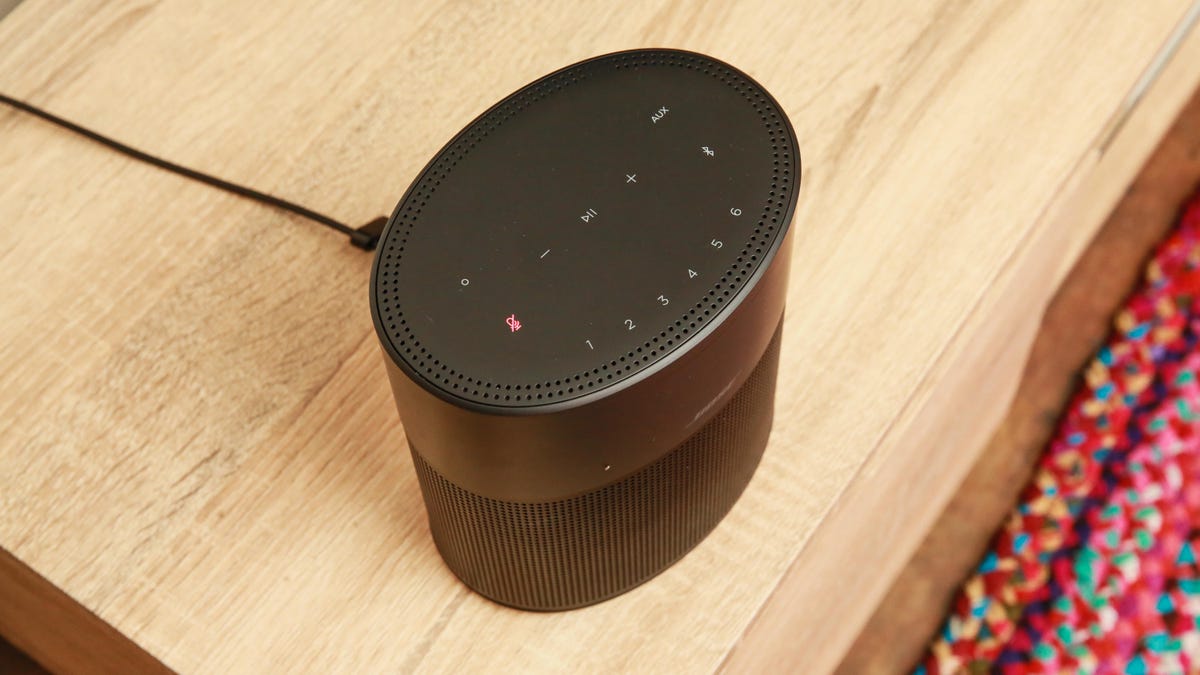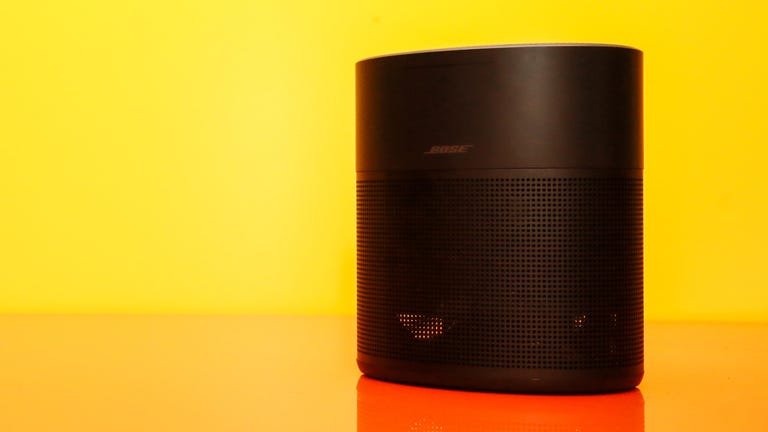 Why You Can Trust CNET
Why You Can Trust CNET Bose Home Speaker 300 review: Solid smart speaker with Alexa and Google, but it's not the One
While its audio quality doesn't measure up to the Sonos One, the Bose Home Speaker 300 gives excellent voice assistant performance.
Google Assistant versus Amazon Alexa. Much like the format wars of yore -- VHS versus Beta, HDR 10 versus Dolby Vision -- it pits two tech ecosystems against one another. Amazon Alexa is more popular, but Google Assistant performs better. But what if you don't want to have to choose between them? What if, instead of a format war, you want peaceful coexistence? You get a smart speaker that does both.
The Good
The Bad
The Bottom Line
The excellent Sonos One was the first such peace offering, but the Bose Home Speaker 300 ($260, £250) is now here to challenge it. A voice-operated speaker with excellent microphone performance, the Bose has a 360-degree driver that makes it less fussy about where you place the speaker in a room.
The Bose 300 is a little pricey, and isn't compatible with the existing Bose SoundTouch range, but its main issue is slightly worse sound quality than the competition. The cheaper Sonos One and more expensive Apple HomePod and Google Home Max all sound better than the Bose, with more presence and better bass response.
If you already own a Bose Home Speaker 500, then the 300 might be worthwhile for building out your whole-home system. Otherwise the Sonos One is a better choice for most people.
Sorry, Bose SoundTouch owners, no Home for you
in 2013 Bose introduced its first multiroom system, SoundTouch, which grew to incorporate sound bars, a subwoofer, adaptors and tabletop speakers. It performed well and no doubt is still enjoyed by many Bose owners. But it's not here to stay.
The SoundTouch range is gradually being phased out in favor of the new Home range, all of which offer the choice of Google Assistant and Amazon Alexa, in addition to Bluetooth and the easy-to-use Home app. At present, Bose Home consists of three products -- Bose Home Speaker 300 ($260), the Bose Home Speaker 500 ($400), and the Bose Soundbar 700 ($800) -- and none of them are compatible with SoundTouch speakers. That's a marked contrast to Sonos, whose new voice speakers like the Sonos One work fine in multiroom systems with older Sonos speakers.
The only caveat to the lack of intercompatibility is that the SoundTouch sub will work with the Soundbar 700.
Design

Ever since SoundTouch came out in 2013, Bose has been playing catch-up with Sonos and the launch of the Home Speaker 300 is no exception: It comes 18 months after the Sonos One. The 300 is not a simple clone though, and it does enough to differentiate itself through its refinement of the original SoundTouch 10 .
The curvy 300 keeps elements from the 10, such as the six shortcut buttons (now capacitive), and adds a 360-degree speaker and the mic array for the voice assistant. It dispenses with the display.
The bottom half of the black speaker is open and through the grille you can see the downward-facing driver, which is dispersed via a series of sound guides. While you could theoretically place this in the center of the room, it's more likely to sit somewhere on the side of your living space or kitchen. If you want to know how far back you'll need to push that toaster, the 300 is 6.3 inches high, 5.6 inches wide and 4 inches deep.
The speaker has a 3.5mm auxiliary input, Bluetooth and Wi-Fi, which brings Apple AirPlay 2 and Spotify Connect along with it. Sadly there's no Google Chromecast built-in to really bolster the Google Assistant's capabilities.
The speaker is controlled via voice, or the new Bose Music app, which is relatively easy to use. Even setting your voice assistant is straightforward. Having used a couple of dual-assistant speakers like the Sonos One and the larger Bose Home Speaker 500, I was delighted to find that Bose has streamlined the process of choosing between the two voice assistants -- to the point of being almost foolproof. Better even than Sonos.
The app also offers EQ settings and I did experiment with these. Reducing the bass made the sound a little more even, but it simultaneously made it sound too thin.
It's worth noting that the Bose Home Speaker 300 currently coexists with the older SoundTouch 10, which is still on sale. The Bose representatives I spoke to were unable to confirm when the SoundTouch would be discontinued.
Bose is a good listener
In my voice tests with the Bose, the Google Home Max and the HomePod with a pink noise track, the Bose 300 was able to pick out commands in a normal speaking voice, even at full volume. In our earlier review of the Home Pod we found that the Apple speaker was very good at picking up fainter voices, but in my newest tests I found that both the Bose and the Google speaker were better able to hear me than the HomePod. I could command both without moving or shouting at a normal 6-foot distance while the speakers were situated at eye level.
How does it sound?
There have been a number of "360-degree sound" speakers from the Apple HomePod to the Samsung R1. In terms of sound quality the Bose Home Speaker 300 fits in the middle of the two of these. It's a little less diffuse than the Samsung, but not as full-sounding as the Apple. It seems Bose has tried to go the "big" and "atmospheric" route with the Home Speaker 300 to mitigate the problems of a smaller cabinet, but it doesn't come off as full-sounding as its competitors or the bigger Home Speaker 500.
There's one thing that can be said about the Home Speaker 300: It can go louder than the HomePod. The Apple speaker struggled to fill the CNET listening room with sound, while the Bose was suitably loud. Not enough to get the party started, but you may need to raise your voice if you want to talk over it.
The diffusion problem reared its head during testing the Bose, and it's something I'd heard with the Samsung R1 back in the day -- possibly a symptom of using a down-facing driver. (This also plagues TV speakers.) At times the vocals and midrange instruments sounded a little like they were in a hallway, a little occluded and distant.
I compared the Bose against all of its rivals in this price bracket, including the Riva Concert and Google Home Max, and found that each of them outperformed the Home Speaker 300. The Bose is the lightest sounding of all the speakers. For example, Feist's funky Inside and Out sounded ineffectual after I heard the bass thump of the Google Max. Even the Apple HomePod sounded better with this disco tune.
It was no surprise that, as the largest speaker in the group, the Google Home Max outclassed the others in terms of slam and pure fun. The Bose Speaker 300 doesn't rock in the same way as the Max with the Prodigy's Voodoo People, or sound as natural as its own big brother the Home Speaker 500. But it wasn't all good news for the Google Max: Its brightness issue is still present -- especially with rock music. Tweaking its EQ to -4 treble and +2 bass made it sound a little more manageable, but I couldn't eradicate the problem entirely.
Meanwhile, the Sonos One sounded more expressive with the post-punk stylings of Bodega: it was sonically focused compared to the oddly lopsided Bose. Too much "air" and not enough bass thrust. 3WW by Alt-J did sound bigger on the Bose, but it was correspondingly less "present" and not as tight as the Sonos. The Bose made the bass drum a little floppy and the deep bass bed ducked in and out (varied in volume) strangely.
Should you buy it?
The Bose offers what most people need in a smart speaker: a choice of assistants, plenty of control options, both Wi-Fi and Bluetooth wireless connectivity, and easy setup and good listening performance. Sound quality is a mixed bag for rock or pop music, but if you like music that's already spacious-sounding -- choral, orchestral, jazz -- then the Bose Home Speaker performs well.
This is a likable speaker, but it's hard to ignore the fact that the Sonos One costs less and sounds a little better. Bose fans looking to start a multiroom system will probably like this speaker just fine, but it would be easier to recommend if its price was closer to the Sonos One's.


